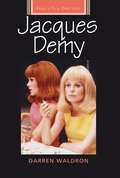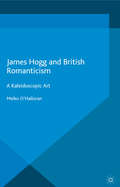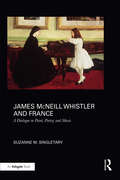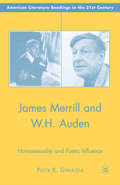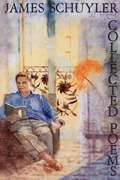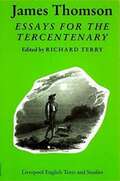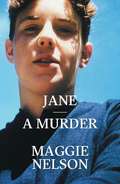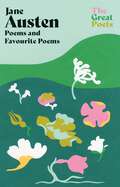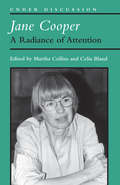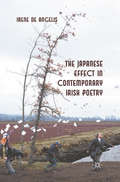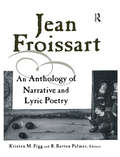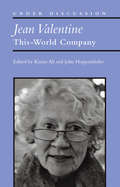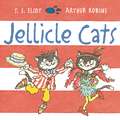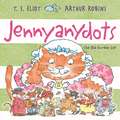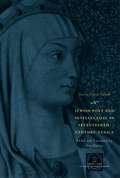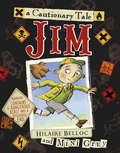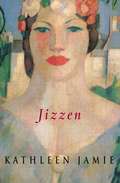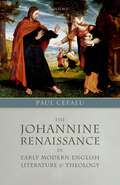- Table View
- List View
Jacques Demy (French Film Directors Series)
by Darren WaldronSaccharine for some, poignant for others, Jacques Demy’s ‘enchanted’ world is familiar to generations of French audiences accustomed to watching Christmas repeats of his fairytale Peau d’âne (1970) or seeing Catherine Deneuve and Françoise Dorléac prance and pirouette in Les Demoiselles de Rochefort (1966). Demy achieved international recognition with Les Parapluies de Cherbourg (1963), which was awarded the Palme d’Or at Cannes. However, beneath the apparently sugary coating of his films lie more philosophical reflections on some of the most pressing issues that preoccupy Western societies, including affect, subjectivity, self/other relations and free will. This wide-ranging book addresses many of the key aspects of Demy's cinema, including his associations with the New Wave, his unique approach to musicals, his adaptations of fairytales, his representations of gender and sexuality and his legacy as an iconic director for generations of audiences and filmmakers.
Jam: Red Ditty Book 4 (Read Write Inc Series (PDF))
by Gill Munton Tim Archbold Ruth MiskinThe Red Ditty Books offer children practice in reading short decodable passages that form an important bridge between reading single words and whole sentences. They reinforce the Read Write Inc. Phonics Set 1 sounds. Each book contains three fun and humorous ditties with linked reading activities to develop accuracy, fluency and comprehension. They also prepare children for reading the longer Storybooks and Non-fiction books. Activities at the start of the books help children to practise the sounds and words they will encounter in the book. Questions to talk about at the end of the story provide an extra opportunity for developing childrens comprehension. The books are part of the Read Write Inc. Phonics programme, developed by Ruth Miskin. The programme is designed to create fluent readers, confident speakers and willing writers. It includes Handbooks, Sounds Cards, Word Cards, Storybooks, Non-fiction, Writing books and an Online resource. Read Write Inc. is fully supported by comprehensive professional development from Ruth Miskin Training.
James Hogg and British Romanticism: A Kaleidoscopic Art
by Meiko O'HalloranThis study argues for Hogg's centrality to British Romanticism, resituating his work in relation to many of his more famous Romantic contemporaries. Hogg creates a unique literary style which, the author argues, is best described as 'kaleidoscopic' in view of its similarities with David Brewster's kaleidoscope, invented in 1816.
James McNeill Whistler and France: A Dialogue in Paint, Poetry, and Music
by Suzanne SingletaryJames McNeill Whistler and France: A Dialogue in Paint, Poetry, and Music is the first full-length and in-depth study to position this painter within the overall trajectory of French modernism during the second half of the nineteenth century and to view the artist as integral to the aesthetic projects of its most original contributors. Suzanne M. Singletary maintains that Whistler was in a unique situation as an insider within the emerging French avant-garde, thereby in an enviable position to both absorb and transform the innovations of others – and that until now, his widespread influence as a catalyst among his colleagues has been neither investigated nor appreciated. Singletary contends that Whistler’s importance rivals that of Manet, whose multi-layered (and often unexpected) interconnections with Whistler are the focus of one chapter. In addition, Whistler’s pivotal role in linking the legacies of Baudelaire, Delacroix, Gautier, Wagner, and other mid-century innovators to the later French Symbolists has previously been largely ignored. Courbet, Degas, Monet, and Seurat complete the roster of French artists whose dialogue with Whistler is highlighted.
James McNeill Whistler and France: A Dialogue in Paint, Poetry, and Music
by Suzanne SingletaryJames McNeill Whistler and France: A Dialogue in Paint, Poetry, and Music is the first full-length and in-depth study to position this painter within the overall trajectory of French modernism during the second half of the nineteenth century and to view the artist as integral to the aesthetic projects of its most original contributors. Suzanne M. Singletary maintains that Whistler was in a unique situation as an insider within the emerging French avant-garde, thereby in an enviable position to both absorb and transform the innovations of others – and that until now, his widespread influence as a catalyst among his colleagues has been neither investigated nor appreciated. Singletary contends that Whistler’s importance rivals that of Manet, whose multi-layered (and often unexpected) interconnections with Whistler are the focus of one chapter. In addition, Whistler’s pivotal role in linking the legacies of Baudelaire, Delacroix, Gautier, Wagner, and other mid-century innovators to the later French Symbolists has previously been largely ignored. Courbet, Degas, Monet, and Seurat complete the roster of French artists whose dialogue with Whistler is highlighted.
James Merrill and W.H. Auden: Homosexuality and Poetic Influence (American Literature Readings in the 21st Century)
by P. GwiazdaJames Merrill and W.H. Auden offers a substantial analysis of the literary and personal relationship between two major twentieth-century poets. As Gwiazda argues, Auden's prominence in the post-World War II American poetry scene as a homosexual poet and critic makes his impact on Merrill particularly noteworthy. Merrill's imaginary recreation of Auden in his occult verse trilogy The Changing Light at Sandover (1982) offers a powerful statement about the dynamics of poetic influence between gay male poets. Combining archival research, textual analysis, and aspects of queer theory, James Merrill and W.H. Auden examines Sandover's implications to the contentious issues of homosexual identity and self-representation.
James Schuyler: Collected Poems (PDF)
by James SchuylerThis collection of poetry showcases the unique talent of James Schuyler and highlights the writing that won him a Pulitzer Prize.
James Thomson: Essays for the Tercentenary (Liverpool English Texts and Studies #35)
by Richard TerryJames Thomson: Essays for the Tercentenary is the first collection of essays devoted exclusively to the works of the eighteenth-century Scottish poet James Thomson. The volume is divided into two sections, the first addressing Thomson’s writings themselves, and the second the reception of his works after his death and their influence on later writers. The first section contains essays analysing the politics and aesthetics of Thomson’s major poems and also a reevaluation of Thomson as a heroic dramatist. The second section capitalises on the certainty felt by many in Thomson’s own century that the poet, especially through his most successful poem The Seasons, had won for himself an indelible fame. This volume provides a definitive reappraisal of his achievement for our own times.
Jane: A Murder
by Maggie NelsonJane tells the spectral story of the life and death of Maggie Nelson's aunt Jane, who was murdered in 1969 while a first-year law student at the University of Michigan. Though officially unsolved, Jane's murder was apparently the third in a series of seven brutal rape-murders in the area between 1967 and 1969. Nelson was born a few years after Jane's death, and the narrative is suffused with the long shadow her murder cast over both the family and her psyche. Jane explores the nature of this haunting incident via a collage of poetry, prose, dream-accounts, and documentary sources, including local and national newspapers, related “true crime” books such as The Michigan Murders and Killer Among Us, and fragments from Jane's own diaries written when she was 13 and 21. Its eight sections cover Jane's childhood and early adulthood, her murder and its investigation, the direct and diffuse effect of her death on Nelson's girlhood and sisterhood, and a trip to Michigan Nelson took with her mother (Jane's sister) to retrace the path of Jane's final hours.
Jane: A Murder
by Maggie NelsonJane tells the spectral story of the life and death of Maggie Nelson's aunt Jane, who was murdered in 1969 while a first-year law student at the University of Michigan. Though officially unsolved, Jane's murder was apparently the third in a series of seven brutal rape-murders in the area between 1967 and 1969. Nelson was born a few years after Jane's death, and the narrative is suffused with the long shadow her murder cast over both the family and her psyche.Jane explores the nature of this haunting incident via a collage of poetry, prose, dream-accounts, and documentary sources, including local and national newspapers, related “true crime” books such as The Michigan Murders and Killer Among Us, and fragments from Jane's own diaries written when she was 13 and 21. Its eight sections cover Jane's childhood and early adulthood, her murder and its investigation, the direct and diffuse effect of her death on Nelson's girlhood and sisterhood, and a trip to Michigan Nelson took with her mother (Jane's sister) to retrace the path of Jane's final hours.
Jane Austen: Poems both inspiring and witty from the author of 'Pride and Prejudice' and 'Emma' (The Great Poets)
by Jane Austen'Another world must be unfurled, Another language known'Best known - and beloved - for her highly popular novels including Pride and Prejudice, Emma and Sense and Sensibility, Jane Austen was also an accomplished, and often witty, poet:'I am going to have my dinner, after which I shan't be thinner'This collection, which also includes poems by the poets she herself admired, sheds light not only on Jane Austen the writer, but on the themes that are woven through her bestselling novels. Satirical, humorous and ironical, they will resonate both with readers who love her novels, and newcomers alike.'When stretched out on one's bed with a fierce throbbing head ... how little one cares for the grandest affairs''I am in a dilemma, for want of an Emma'
Jane Cooper: A Radiance of Attention (Under Discussion)
by Martha Collins Celia BlandThough she published only five volumes of poetry over the course of her career, Jane Cooper (1924–2007) was deeply admired by her contemporaries, and teaching at Sarah Lawrence College for nearly forty years, she served as a mentor to many aspiring poets. Her elegant, honest, and emotionally and formally precise poems, often addressing the challenges of women’s lives—especially the lives of women in the arts—continue to resonate with a new generation of readers. Martha Collins and Celia Bland bring together several decades’ worth of essential writing on Cooper’s poetry. While some pieces offer close examination of Cooper’s process or thoughtful consideration of the craft of a single poem, the volume also features reviews of her collections, including a previously unpublished piece on her first book, The Weather of Six Mornings (1969), by James Wright, a lifelong champion of her work. Marie Howe, Jan Heller Levi, and Thomas Lux, among others, share personal remembrances of Cooper as a teacher, colleague, and inspiration. L. R. Berger’s moving tribute to Cooper’s final days closes the volume. This book has much to offer for both readers who already love Cooper’s work and new readers, especially among younger poets, just discovering her enduring poems.
The Japanese Effect in Contemporary Irish Poetry
by Irene De AngelisThe Japanese Effect in Contemporary Irish Poetry provides a stimulating, original and lively analysis of the Irish-Japanese literary connection from the early 1960s to 2007. While for some this may partly remain Oscar Wilde's 'mode of style', this book will show that there is more of Japan in the work of contemporary Irish poets than 'a tinkling of china/ and tea into china.' Drawing on unpublished new sources, Irene De Angelis includes poets from a broad range of cultural backgrounds with richly varied styles: Seamus Heaney, Derek Mahon, Ciaran Carson and Paul Muldoon, together with younger poets such as Sinéad Morrissey and Joseph Woods. Including close readings of selected poems, this is an indispensable companion for all those interested in the broader historical and cultural research on the effect of oriental literature in modernist and postmodernist Irish poetry.
Jean Froissart: A Dual Language Anthology
by R. Barton Palmer Kristen M. FiggFirst published in 2002. Jean Froissart is probably the best known medieval historians. His Chronicle (of the Hundred Years War) is among the top ten historical works in western civilization. In his own time, though, he was better known as a poet. This is the first dual language anthology including excepts from Chroniques, as well as several of his verse and prose.
Jean Froissart: A Dual Language Anthology
by R. Barton Palmer Kristen M. FiggFirst published in 2002. Jean Froissart is probably the best known medieval historians. His Chronicle (of the Hundred Years War) is among the top ten historical works in western civilization. In his own time, though, he was better known as a poet. This is the first dual language anthology including excepts from Chroniques, as well as several of his verse and prose.
Jean Valentine: This-World Company (Under Discussion)
by Mohammed Kazim Ali John HoppenthalerOver the course of more than four decades, contemporary American poet Jean Valentine has written eleven books of stunning, spirit-inflected poetry. This collection of essays, assembled over several years by Kazim Ali and John Hoppenthaler, brings together twenty-six pieces on all stages of Valentine's career by a range of poets, scholars, and admirers. Valentine's poetry has long been valued for its dreamlike qualities, its touches of the personal and the political, and its mesmerizing phrasing. Valentine is a National Book Award winner and was named the State Poet of New York in 2008. She has taught a number of popular workshops and has been awarded a Bunting Institute Fellowship, a Guggenheim Foundation Fellowship, and the Shelley Memorial Prize.
Jellicle Cats (Old Possum's Cats)
by T. S. EliotJellicle Cats come one and all.Jellicles come to the Jellicle Ball.Join the Jellicle Cats under the Jellicle Moon in the forth picture-book pairing from Arthur Robins and T. S. Eliot's Old Possum's cats, as they dance the night away.To sit alongside other classics such as The Gruffalo, The Tiger Who Came to Tea, and Spot.
Jelly Boots, Smelly Boots
by Michael Rosen_______________A wonderful poetry collection fizzing with fun from the much loved Michael Rosen, packed with colour illustrations by David Tazzyman. Includes an audio CD of Michael Rosen reading his poems.A riotous celebration of words – silly words, funny words, words you only use in your own family, new words, old words, and the very best words in the right order.MelonMelon squashy,melon sloshy.My friend Helen's eating melon.So far, so goodwith Helenand her melon.But here's what I'm tellin'Helen:'Don't SIT on your melon, Helen!'Filled with colour illustrations and packed with silly rhymes, witty wordplay and thought-provoking story poems, this collection will delight children of all ages. Michael Rosen is the bestselling author of We're Going on a Bear Hunt, along with many other picture books and collections of poetry.
Jennyanydots: The Old Gumbie Cat (Old Possum's Cats)
by T. S. EliotI have a Gumbie Cat in mind, her name is Jennyanydots.Her coat is of the tabby kind, with tiger stripes and leopard spots.All day she sits upon the stair or on the steps or on the mat:She sits and sits and sits and sits - and that's what makes a Gumbie Cat!But the Old Gumbie Cat gets busy at the end of the day, teaching and cooking, and getting the mice, cockroaches and beetles organised!The sixth gorgeous Cats picture book with lively and colourful illustrations by Arthur Robins.
Jewish Poet and Intellectual in Seventeenth-Century Venice: The Works of Sarra Copia Sulam in Verse and Prose Along with Writings of Her Contemporaries in Her Praise, Condemnation, or Defense (The Other Voice in Early Modern Europe)
by Sarra Copia SulamThe first Jewish woman to leave her mark as a writer and intellectual, Sarra Copia Sulam (1600?–41) was doubly tainted in the eyes of early modern society by her religion and her gender. This remarkable woman, who until now has been relatively neglected by modern scholarship, was a unique figure in Italian cultural life, opening her home, in the Venetian ghetto, to Jews and Christians alike as a literary salon. For this bilingual edition, Don Harrán has collected all of Sulam’s previously scattered writings—letters, sonnets, a Manifesto—into a single volume. Harrán has also assembled all extant correspondence and poetry that was addressed to Sulam, as well as all known contemporary references to her, making them available to Anglophone readers for the first time. Featuring rich biographical and historical notes that place Sulam in her cultural context, this volume will provide readers with insight into the thought and creativity of a woman who dared to express herself in the male-dominated, overwhelmingly Catholic Venice of her time.
Jewish Poet and Intellectual in Seventeenth-Century Venice: The Works of Sarra Copia Sulam in Verse and Prose Along with Writings of Her Contemporaries in Her Praise, Condemnation, or Defense (The Other Voice in Early Modern Europe)
by Sarra Copia SulamThe first Jewish woman to leave her mark as a writer and intellectual, Sarra Copia Sulam (1600?–41) was doubly tainted in the eyes of early modern society by her religion and her gender. This remarkable woman, who until now has been relatively neglected by modern scholarship, was a unique figure in Italian cultural life, opening her home, in the Venetian ghetto, to Jews and Christians alike as a literary salon. For this bilingual edition, Don Harrán has collected all of Sulam’s previously scattered writings—letters, sonnets, a Manifesto—into a single volume. Harrán has also assembled all extant correspondence and poetry that was addressed to Sulam, as well as all known contemporary references to her, making them available to Anglophone readers for the first time. Featuring rich biographical and historical notes that place Sulam in her cultural context, this volume will provide readers with insight into the thought and creativity of a woman who dared to express herself in the male-dominated, overwhelmingly Catholic Venice of her time.
Jewish Poet and Intellectual in Seventeenth-Century Venice: The Works of Sarra Copia Sulam in Verse and Prose Along with Writings of Her Contemporaries in Her Praise, Condemnation, or Defense (The Other Voice in Early Modern Europe)
by Sarra Copia SulamThe first Jewish woman to leave her mark as a writer and intellectual, Sarra Copia Sulam (1600?–41) was doubly tainted in the eyes of early modern society by her religion and her gender. This remarkable woman, who until now has been relatively neglected by modern scholarship, was a unique figure in Italian cultural life, opening her home, in the Venetian ghetto, to Jews and Christians alike as a literary salon. For this bilingual edition, Don Harrán has collected all of Sulam’s previously scattered writings—letters, sonnets, a Manifesto—into a single volume. Harrán has also assembled all extant correspondence and poetry that was addressed to Sulam, as well as all known contemporary references to her, making them available to Anglophone readers for the first time. Featuring rich biographical and historical notes that place Sulam in her cultural context, this volume will provide readers with insight into the thought and creativity of a woman who dared to express herself in the male-dominated, overwhelmingly Catholic Venice of her time.
Jim (Joy Street Bks.)
by Hilaire BellocAward-winning illustrator Mini Grey turns her inimitable hand to Hilaire Belloc's classic cautionary tale of Jim: who ran away from his Nurse and was eaten by a Lion!First published in 1907, Belloc's wickedly funny poem describing the sad end of Jim is fabulously illustrated in a magical picture book edition. This is darkly comic, word of warning about the dangers of being spoiled is the perfect tongue-in-cheek corrective for little ones who have been a little overindulged!
Jizzen
by Kathleen JamieThese poems unfold with a supernatural intensity, alternately dark and celebratory, that set them apart from other treatments of the subject. Through the perspectives of emigrant and native, critic and intimate, Jamie addresses Scotland in all its living complexity. Jizzen reveals a writer coming into poetic maturity just as her nation begins to fully assume its own identity. The result is a poetry both worldly and other-worldly, remarkable it its humanity, political sophistication and lyric authority. ‘With The Queen of Sheba Kathleen Jamie has produced the best individual collection of poems by a woman living in twentieth-century Scotland. The book establishes her eminence among Scottish poets of her generation . . . The precision and resource of her language have never been combined more impressively than here’ Robert Crawford, Scotsman
The Johannine Renaissance in Early Modern English Literature and Theology
by Paul CefaluThe Johannine Renaissance in Early Modern English Literature and Theology argues that the Fourth Gospel and First Epistle of Saint John the Evangelist were so influential during the early modern period in England as to share with Pauline theology pride of place as leading apostolic texts on matters Christological, sacramental, pneumatological, and political. The book argues further that, in several instances, Johannine theology is more central than both Pauline theology and the Synoptic theology of Matthew, Mark, and Luke, particularly with regard to early modern polemicizing on the Trinity, distinctions between agape and eros, and the ideologies of radical dissent, especially the seventeenth-century antinomian challenge of free grace to traditional Puritan Pietism. In particular, early modern religious poetry, including works by Robert Southwell, George Herbert, John Donne, Richard Crashaw, Thomas Traherne, and Anna Trapnel, embraces a distinctive form of Johannine devotion that emphasizes the divine rather than human nature of Christ; the belief that salvation is achieved more through revelation than objective atonement and expiatory sin; a realized eschatology; a robust doctrine of assurance and comfort; and a stylistic and rhetorical approach to representing these theological features that often emulates John's mode of discipleship misunderstanding and dramatic irony. Early modern Johannine devotion assumes that religious lyrics often express a revelatory poetics that aims to clarify, typically through the use of dramatic irony, some of the deepest mysteries of the Fourth Gospel and First Epistle.
